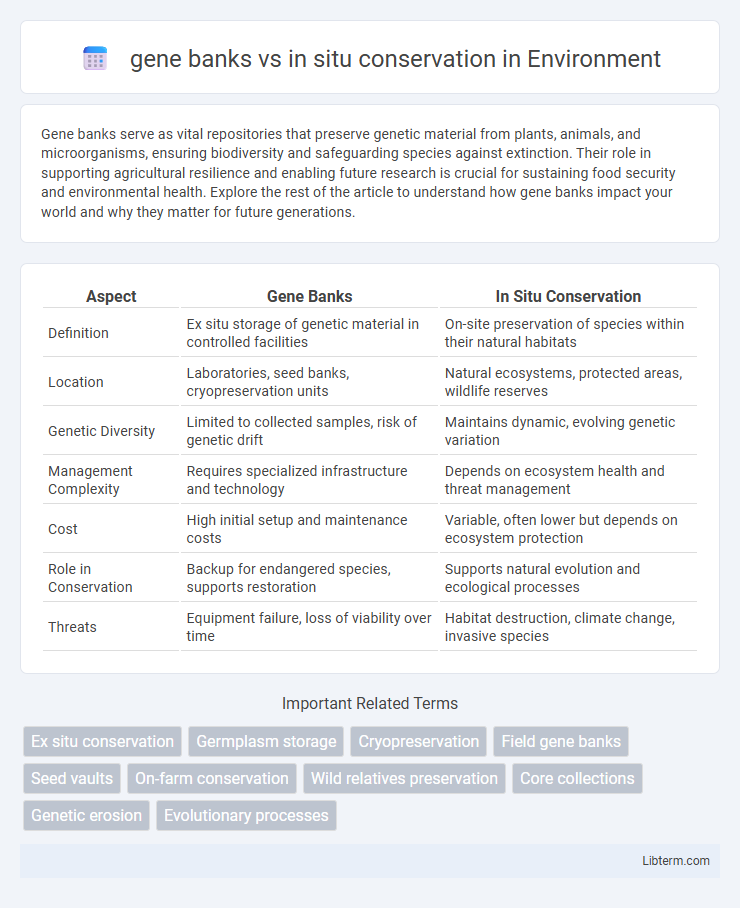Gene banks serve as vital repositories that preserve genetic material from plants, animals, and microorganisms, ensuring biodiversity and safeguarding species against extinction. Their role in supporting agricultural resilience and enabling future research is crucial for sustaining food security and environmental health. Explore the rest of the article to understand how gene banks impact your world and why they matter for future generations.
Table of Comparison
| Aspect | Gene Banks | In Situ Conservation |
|---|---|---|
| Definition | Ex situ storage of genetic material in controlled facilities | On-site preservation of species within their natural habitats |
| Location | Laboratories, seed banks, cryopreservation units | Natural ecosystems, protected areas, wildlife reserves |
| Genetic Diversity | Limited to collected samples, risk of genetic drift | Maintains dynamic, evolving genetic variation |
| Management Complexity | Requires specialized infrastructure and technology | Depends on ecosystem health and threat management |
| Cost | High initial setup and maintenance costs | Variable, often lower but depends on ecosystem protection |
| Role in Conservation | Backup for endangered species, supports restoration | Supports natural evolution and ecological processes |
| Threats | Equipment failure, loss of viability over time | Habitat destruction, climate change, invasive species |
Introduction to Genetic Resource Conservation
Gene banks store seeds, tissues, or genetic material ex situ to preserve plant and animal genetic diversity under controlled conditions, ensuring long-term conservation and availability for breeding programs. In situ conservation maintains species within their natural habitats, allowing ongoing evolution and adaptation to environmental changes, which supports ecosystem resilience. Both methods are essential for genetic resource conservation, balancing preservation with natural evolutionary processes.
Defining Gene Banks: An Overview
Gene banks are dedicated facilities that store genetic material such as seeds, tissues, or DNA to preserve plant, animal, and microbial biodiversity ex situ. These banks enable long-term conservation by maintaining samples under controlled conditions, ensuring genetic resources are available for future breeding, research, and restoration efforts. Unlike in situ conservation, which preserves species in their natural habitats, gene banks provide a backup to protect against habitat loss, climate change, and other environmental threats.
Understanding In Situ Conservation
In situ conservation involves protecting and managing species within their natural habitats, maintaining ecological processes and evolutionary dynamics essential for biodiversity preservation. This approach supports the survival of species in complex ecosystems, allowing adaptation to environmental changes and promoting genetic diversity. Unlike gene banks, which store genetic material ex situ, in situ conservation ensures continuous interactions between organisms and their environment, crucial for long-term species resilience.
Objectives of Ex Situ and In Situ Methods
Gene banks aim to preserve genetic diversity by storing seeds, tissues, or genetic material under controlled conditions to safeguard against loss due to environmental changes or human activities. In situ conservation focuses on maintaining species within their natural habitats, promoting evolutionary processes and ecosystem interactions to ensure long-term survival and adaptability. Both methods target biodiversity preservation but differ in approach: gene banks secure genetic resources ex situ, while in situ conservation supports dynamic natural populations.
Advantages of Gene Banks
Gene banks provide secure, long-term preservation of genetic material, enabling the safeguarding of biodiversity against environmental changes and catastrophic losses. They offer controlled storage conditions that maintain seed viability and genetic integrity, facilitating efficient resource management and easy access for research and breeding programs. Unlike in situ conservation, gene banks reduce the risk of genetic erosion caused by pests, diseases, or habitat destruction, ensuring stable and reliable conservation of valuable genetic resources.
Benefits of In Situ Conservation
In situ conservation preserves plant and animal species within their natural habitats, maintaining ecological processes and promoting genetic diversity through natural selection. It supports the adaptation of species to changing environmental conditions and helps conserve associated ecosystems and cultural values. This approach enables continuous evolution, ensuring long-term species survival in dynamic environments.
Challenges Facing Gene Banks
Gene banks face significant challenges such as genetic erosion due to seed viability loss and limited funding for long-term storage and maintenance. The complexity of conserving diverse species with varying storage requirements strains infrastructure and technical expertise. Climate change further threatens the stability of stored genetic resources, making continuous monitoring and backup strategies crucial for effective ex situ conservation.
Limitations of In Situ Conservation
In situ conservation faces limitations such as habitat loss due to urbanization, climate change effects that alter ecosystem dynamics, and difficulties in managing genetic diversity within natural populations. Threats like invasive species and poaching further compromise the survival of endangered species in their natural habitats. Unlike gene banks, which store genetic material ex situ under controlled conditions, in situ methods depend heavily on the stability and protection of the environment, making long-term preservation challenging.
Complementarity Between Gene Banks and In Situ Conservation
Gene banks and in situ conservation offer complementary approaches to preserving genetic diversity, with gene banks providing secure, long-term storage of seeds and genetic material, while in situ conservation maintains species within their natural habitats, allowing for ongoing adaptation and evolution. Gene banks safeguard genetic resources against catastrophic loss, ensuring availability for future breeding and restoration efforts, whereas in situ conservation supports ecosystem health, species interactions, and environmental resilience. Combining both methods enhances overall biodiversity conservation by protecting genetic variation both ex situ and in natural contexts, thus promoting sustainable agricultural and ecological outcomes.
Future Directions for Conservation Strategies
Future conservation strategies emphasize integrating gene banks with in situ conservation to enhance genetic diversity preservation and ecosystem resilience. Advanced biotechnological tools such as cryopreservation and genomic sequencing are being developed to improve gene bank storage capabilities and facilitate the restoration of endangered species in their natural habitats. Combining ex situ genetic resources with habitat protection supports adaptive management approaches critical for coping with climate change and habitat fragmentation.
gene banks Infographic

 libterm.com
libterm.com